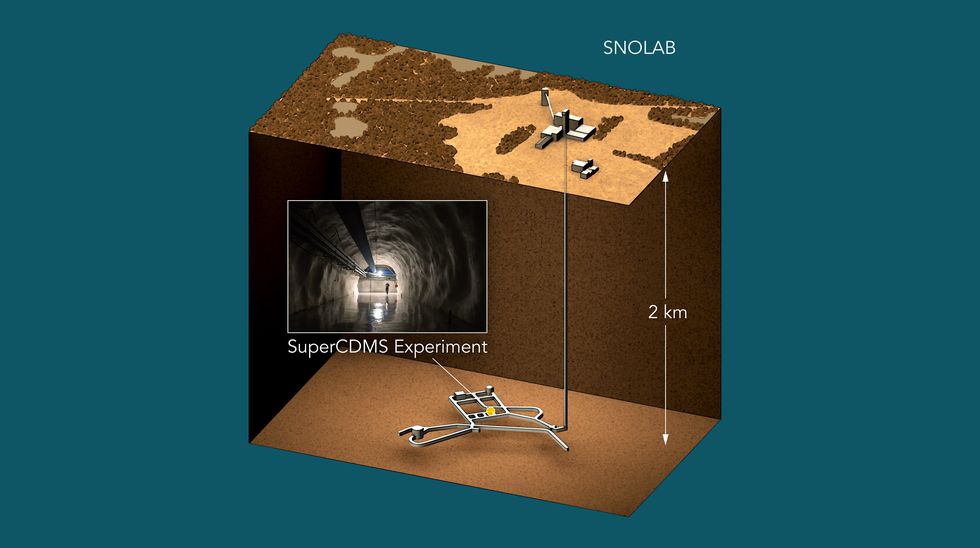
For decades, astrophysicists have pondered the odd movements of galaxies across the cosmos. The visible matter of the universe appears to be tugged around by an invisible counterpart, material that does not interact with surrounding matter in any observable way save gravity: dark matter. Refined measurements have since led scientists to hypothesize that 85 percent of all the matter in the universe is dark matter, while only 15 percent accounts for you, me, the planet, the stars, and everything else we can see.
It’s a satisfactory explanation for our observations that has one major problem: a dark matter particle has never been detected directly. But the search for elusive dark matter is about to get a shot in the arm, and rather than looking for evidence of the substance written in the stars, scientists are constructing ambitious experiments deep underground.
The SLAC National Accelerator Laboratory, partnered with Stanford University and multiple additional labs and universities around the world, just announced that the U.S. Department of Energy has approved funding and construction a of dark matter experiment 6,800 feet underground in an old nickel mine. The project, called the SuperCDMS SNOLAB experiment, will use supercooled silicon and germanium crystals in an attempt to detect dark matter particles as they pass through our planet. The experiment is expected to be 50 times more sensitive than previous efforts, and it is slated to come online in the early 2020s.

The DOE’s Office of Science just approved $19 million to fund the project, which will also receive $12 million from the National Science Foundation and $3 million from the Canada Foundation for Innovation. The experiment is the newest in a series of revamped attempts to find dark matter, including another multi-million-dollar project in an abandoned South Dakota gold mine using a vat of 10 tons of liquid xenon as a dark-matter detector. Multiple smaller-scale experiments have attempted to detect dark matter, but so far, none have been fruitful.
In theory, dark matter particles should be everywhere, flying freely though normal matter without anyone being any the wiser. The gravitational pull of dark matter is notable in the behavior of galaxies, but the particles themselves are practically imperceptible (if they do indeed exist). The hypothetical building blocks of dark matter are called WIMPs, or weakly interacting massive particles.
“Our experiment will be the world’s most sensitive for relatively light WIMPs—in a mass range from a fraction of the proton mass to about 10 proton masses,” said Richard Partridge, head of the SuperCDMS group at the Kavli Institute for Particle Astrophysics and Cosmology (KIPAC), in a press release. “This unparalleled sensitivity will create exciting opportunities to explore new territory in dark matter research.”
The SuperCDMS, or Super Cryogenic Dark Matter Search, will take place at the SNOLAB facilities near the city of Sudbury in Ontario. Scientists have used the facilities, situated in an old nickel mine more than a mile underground, to study neutrinos in the past. In the subterranean mine, the experiment will be shielded from interference from charged cosmic particles hitting the Earth from space.
WIMPs are believed to pass though ordinary matter without any notable effects most of the time. Occasionally, however, a dark matter particle should collide with a visible matter particle. These impacts—if they occur—are incredibly difficult to detect because they happen so rarely and are generally drowned out by interference from a cacophony of other atomic collisions.
In the newest attempt to catch a dark matter particle in action, physicists will use silicon and germanium crystals cooled to negative 459.6 degrees Fahrenheit, just a fraction of a degree above absolute zero. At absolute zero—which we cannot achieve fully—particles stop moving entirely. It’s the coldest that matter can possibly be. Near this state, any movement on the atomic level should be detectable.
The crystals, each resembling an oversized hockey puck, will be arranged in four detector towers. Each tower will contain six crystals slotted into their own units, and the four towers will be placed in a cryogenic container called the SNOBOX to cool the experiment to near absolute zero. The SNOBOX and all four towers will live underground in the mine, waiting for dark matter to come along and give the crystals a nudge.

“The detector towers are the most technologically challenging part of the experiment, pushing the frontiers of our understanding of low-temperature devices and superconducting readout,” said Bernard Sadoulet, a collaborator on the project from the University of California, Berkeley.
If a WIMP does show itself by impacting a particle in the crystal detectors, a series of tiny vibrations will reverberate through the substance. The collisions should also produce pairs of electrons, triggering electron deficiencies that would amplify the atomic vibrations in the material.
In preparation for the experiment, the SLAC Nuclear Accelerator Laboratory built and tested a prototype detector. “These tests were an important demonstration that we’re able to build the actual detector with high enough energy resolution, as well as detector electronics with low enough noise to accomplish our research goals,” said KIPAC’s Paul Brink, who oversees the detector fabrication at Stanford.
The first detector tower could be delivered to SNOLAB by the end of the year. Once the experiment is up and running, there is nothing to do but wait for a WIMP, potentially for months and months. If a dark matter particle hits one of the crystal detectors, ringing it like an atomic bell, then astronomers and physicists will finally have strong experimental evidence that dark matter is indeed the cause of strange movements in the sky.
If the scientists hear silence, the hunt for dark matter, and an explanation for the behavior of the universe, will continue.

